General Gaede's Tactical Significance
Pierre's WFA-NL lecture of 28 April 2012
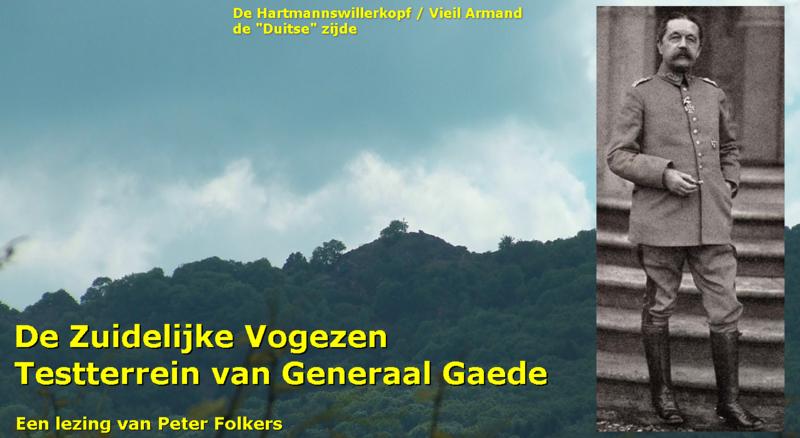
Preface
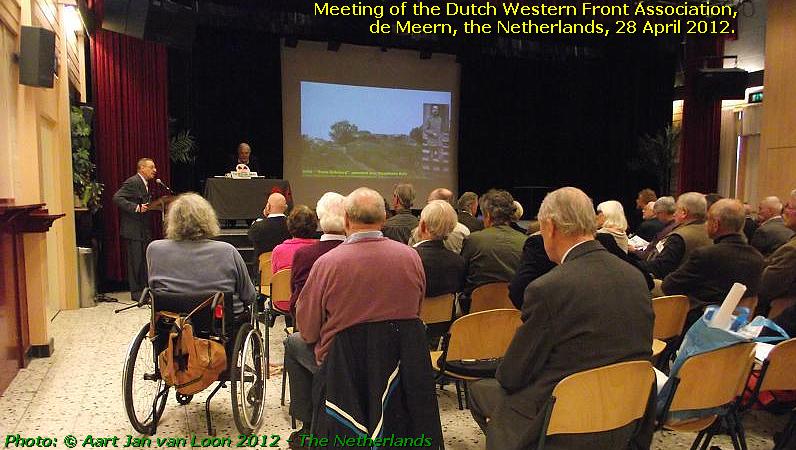
You are going to read my story about the tactical significance of the forgotten German General Gaede. Originally I wrote this text for a special occasion and for a select group. The text was initially not meant to be published on this website.
On 28 April 2012 I had the honour to give a lecture to the members of the Western Front Association of the Netherlands , an association of which I am also a proud member myself.
Due to the unexpectedly large number of questions and especially because of the many oral comments afterwards, but also because of the many written requests from distant corners of the world via Facebook or via email, I decided to present to you integrally in two languages the text of this apparently successful lecture.
For the images I have of course made use of the projections, which I've used during my reading.
I realize very well that the text deserves in many places some supplements, but I limited myself to a speech time of up to 50 minutes. Incidentally, you will find many of the sub-topics also covered elsewhere, here on my website, or these topics can be found in detail in the extensive survey of sources, that follows after the end of the text of my lecture .
I would like to present to you now my lecture:

The Southern Vosges – Test Terrain of General Gaede
Introduction
Today I shall try to extricate a person from his underserved oblivion. He is the German General der Infanterie, Hans Gaede.
The reason that I shall dwell in my lecture on the guard of the German border of the Southern Vosges and of the Sundgau is not because Gaede had a very interesting character, or because he died heroically on the battlefield. On the contrary. I will even deliberately let the character of the man, Gaede, off the hook, because I think that you evaluate a man most objectively and best by looking at his deeds and his intellectual legacy. There are five other, important reasons why I want to bring this influential General to your notice.
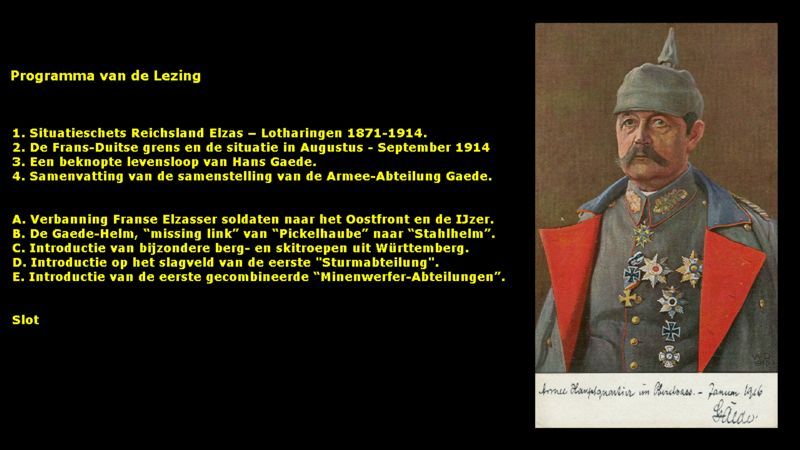
Before explaining these five reasons I will refresh your memory with a concise introduction of:
1. A Sketch of the “Reichsland Elzaẞ – Lothringen” between 1871 and 1914.
2. The Franco-German border and the situation in August-September 1914.
3. A brief survey of the life of Hans Gaede and
4. A brief summary of the composition of the Armee-Abteilung Gaede.
After these four introduction points, I will present five reasons why I consider General Gaede to be so important.
General Gaede was responsible for:
A. the idea of exile from the Franco-German Alsace of soldiers of French descent to the Eastern Front and the Yzer Front in Belgium,
B. the development and introduction of the "missing link" in the evolutionary development from the "Pickelhaube" helmet to the "Stahlhelm", the " Gaede helmet ".
C. the introduction of elite mountain and ski troops from Württemberg, who would later prove to be very successful in the Alps.
D. the introduction of a specialized light attack unit and the first experiments under battle conditions with "Sturmabteilung" - units that later in the war would be so successful on other fronts than in the Vosges.
E. the introduction of the first combined "Minenwerferabteilungen" with mortars of different calibre.
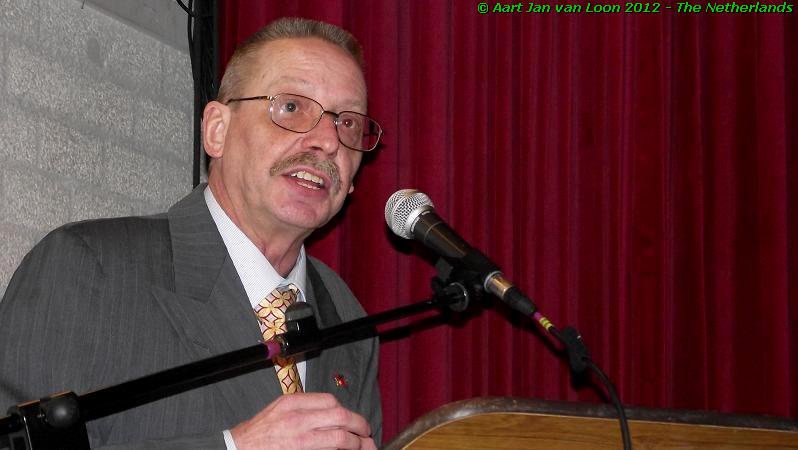
What do I want to tell you with my five reasons?
Under his responsibility of “Befehlshaber der Armee-Abteilung Gaede” General Gaede offered his officers the creative space to develop on the basis of the last battle experiences new tactical ideas and also to test these ideas in the fights on his battlefield in the Vosges with the aim of improving the protection of the soldier and the attacking power of the Army Detachment .
I consider Gaede, in the modern sense of the word, to be an innovator, a successful manager of crisis and change, who was open minded to new ideas to solve current problems.
Alsace-Lorraine and the Vosges between 1871 and 1914
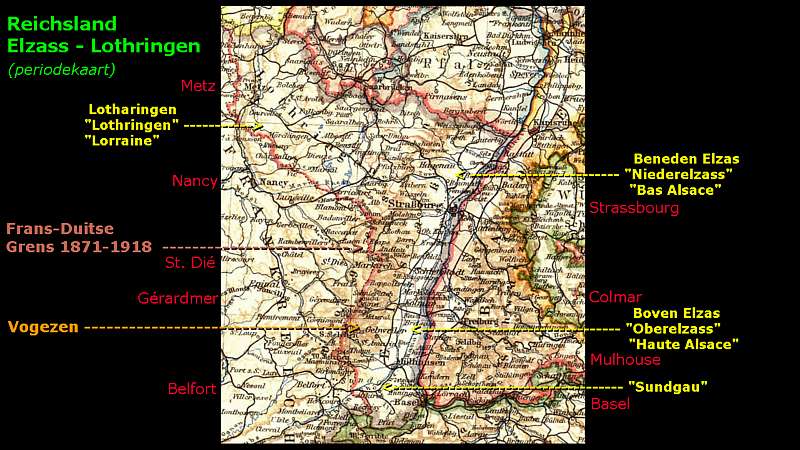
In order to refresh your memory I will first sketch briefly the position of Alsace-Lorraine and the Vosges between 1871 and 1914.
At the end of the Franco-Prussian war of 1870-1871 von Bismarck annexes Alsace-Lorraine in the new German Empire. Unlike the other provinces of the Empire, from the annexation the "Reichsland Elsaẞ-Lothringen" is governed directly by the administration of Berlin with a status comparable to that of a colony. Only in 1911 would Alsace-Lorraine become almost the same as the other provinces of the Empire with the establishment of a "Landtag" of two chambers.
In 1871 the German authorities enact in the "Reichsland Elsaẞ-Lothringen" immediately German laws, which of course also apply to the French-speaking population of Alsace. Until October 1872 the French population has only one option: Becoming a citizen of Germany or otherwise leave for France. Of the nearly 1,5 million Frenchmen in Alsace nearly 160,000 people choose to leave Alsace for French territory.
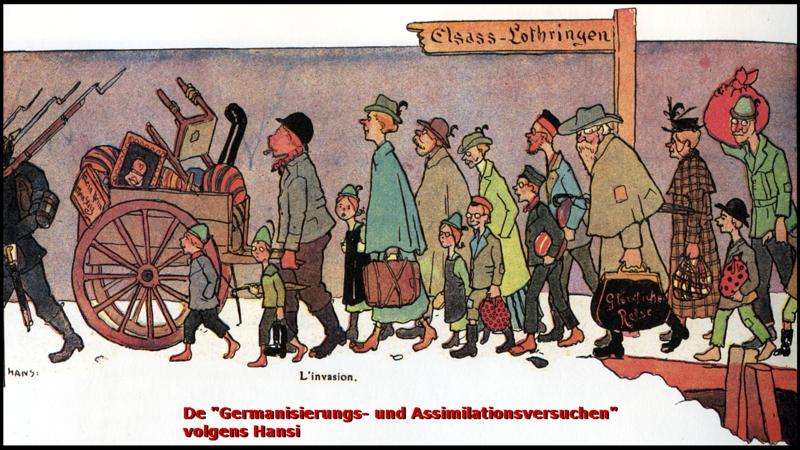
From 1872 the German government promotes with its " Germanisierungs-und Assimilationsversuchen " the immigration of Germans from other parts of the Empire.
After 42 years of annexation the German population of Alsace grows by the German immigration from about 400,000 German inhabitants in 1871 to 1,8 million residents in 1914.
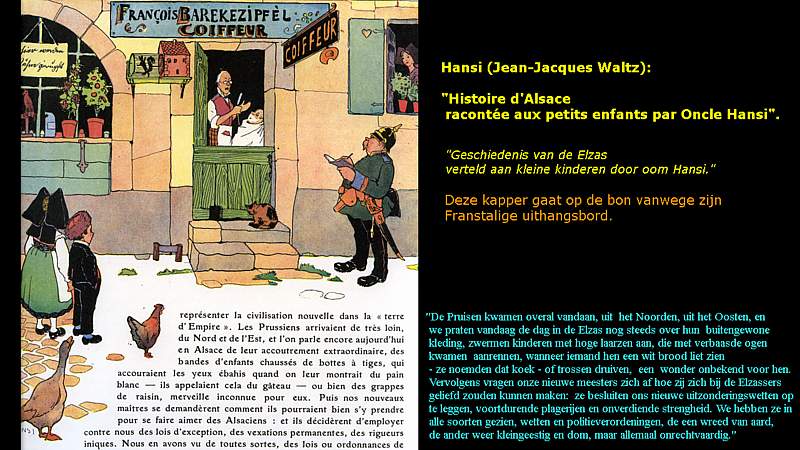
Now the official language is German. Schools are required to teach only in German. French billboards or other French expressions in public are prohibited. The members of the French population are excluded from all public functions. The press is censored. The French men are subject to the German military laws and conscription .
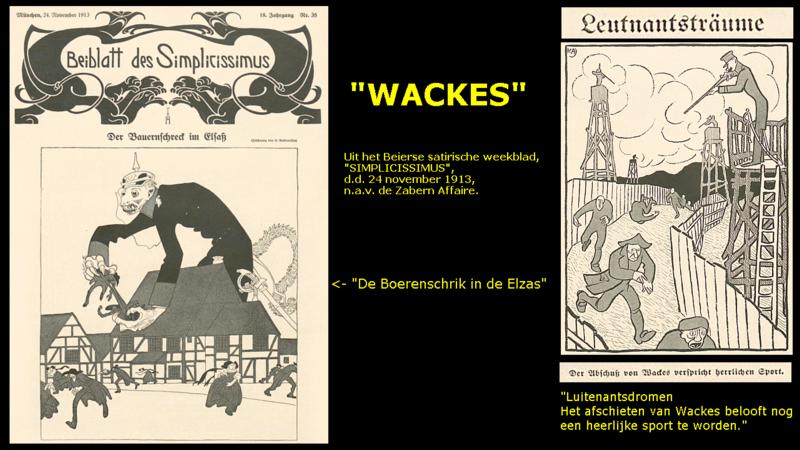
The Germans regarded the French population of Alsace as a kind of inferior "Untermenschen". The German officers regularly used a term of abuse for the people, a term that they also preferred to use relating to their French soldiers, " Wackes ", which means tramps.
Typical of this hostility is this remark of General Gaede, who once in early 1916 in Kaysersberg said: “Das Land gefählt mir, aber die Bevölkerung muss vernichtet werden”. ("I like the country, but the population has to be destroyed").
Before the outbreak of the Great War many German soldiers and officers consider the Alsace as "Feindesland", enemy country.
The Franco-German border and the situation in August-September 1914
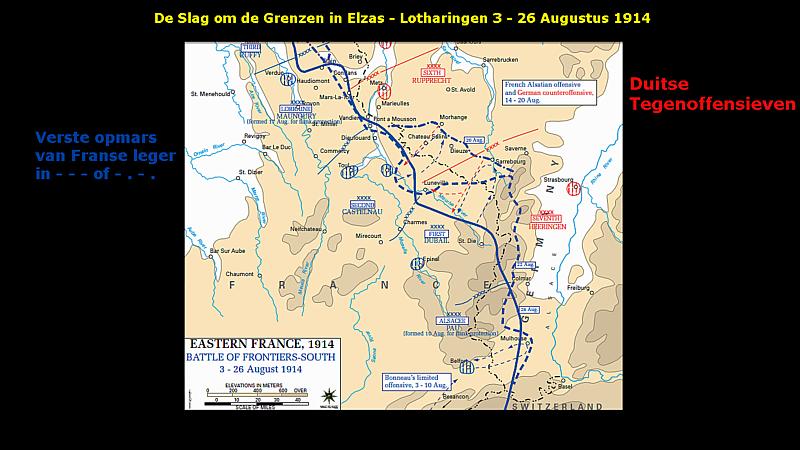
At the outset, during the first days of the war, Joffre deploys his forces from 3 August 1914 on his "Plan 17" to re-conquer the lost territories of Alsace-Lorraine. French troops massively exceed the borders of Lorraine, the Vosges and the Sundgau.
The task of the troops of General von Heeringen's 7th Army is to stop this already expected, but also partly successful advance of the French troops over the borders in the Vosges.
Under pressure of the French advance from mid-August 1914, also further north, in Lorraine and in the Northern Vosges, von Heeringen is forced to cede some of his units to Crown Prince Rupprecht's Sixth Army southwest of Nancy. Von Heeringen is also forced to reorganize thoroughly his 7th Army.
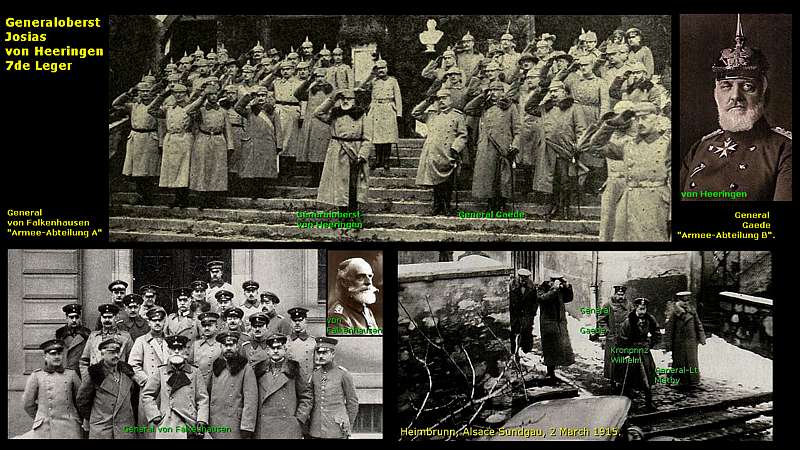
In the Northern Vosges General von Falkenhausen's "Armee-Abteilung A" defends from 14 August 1914 the front along the border.
In the Southern Vosges, the French - and this is still often overlooked - continue to occupy, despite their retreat a front line, which is largely located on German 1871-1918 territory!
In the Vosges and south thereof, from the Col du Bonhomme, either Diedolshausen, the village, which now is called le Bonhomme, southwards to the Swiss border near Pfetterhouse, the " Truppen-Abteilung Gaede " guarded the front from 19 August 1914.
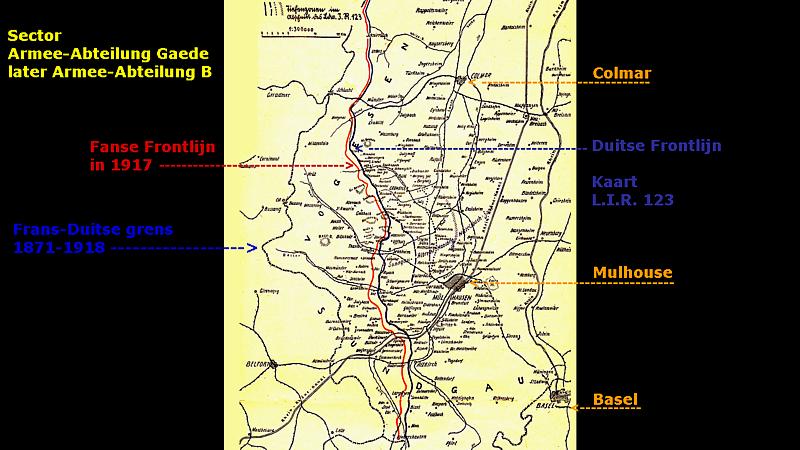
Within a few months later, the composition of this "Truppen-Abteilung Gaede" will change its name. It will eventually become the "Armee-Abteilung Gaede."
General Joffre is also forced to reorganize his French Alsace Army on 28 August 1914. In the Vosges Joffre appoints General Putz to commander of the new "Groupement des Vosges", the Army Group of the Vosges.
The life of the Officer Gaede

Rest assured, dear friends, I will not guide you in detail through his life history!
Hans Emil Alexander Gaede was born on February 19, 1852 in Kolberg, WestPommern, the current Kolobrezg in Poland. Hans Gaede is intelligent and studies mathematics in Bonn and Berlin. After his studies, on 1 April 1870, this "Fahnenjunker" volunteers for service in the Pomeranian Grenadier Regiment Nr. 2, which has its basis in Stettin.
During the Franco - Prussian War, he fights in the famous battle of Gravelotte-St Privat (16 to 18 August 1870). During this war and the years after he climbs quickly up to the rank of "Leutnant" and then enters, in 1874, the "Preussische Kriegs Akademie" in Berlin.
On 13 April 1878 Gaede is detached to the cartography department of the General Staff in Berlin. From that date, Gaede’s career progresses quickly and he fulfils many senior positions. In March 1907 he leaves active service as a “Generalleutnant”.
At the outbreak of the Great War, however, Gaede, as a resident of Freiburg in the Grand Duchy of Baden, goes again into service at the age of 62, and he is detached to a part of von Heeringen's 7th Army: the 14th Army Corps. His function is "Stellvertreter", deputy commander, of the Prussian General Von Hoiningen-Huene.
On 19 August 1914 General Von Gaede will receive from von Heeringen the order to guard with six Landwehr Brigades the border and the front of the Upper Alsace, which he would continue to do almost until his death.
On 25 August 1915 the General will receive the highest German honour, the medal of "Pour le Mérite".

During the Great War his career will be of short duration and lasts only two years. On 3 September 1916, Gaede is forced to go on immediate sick leave due to serious health conditions. That day General der Infanterie Erich von Gundell takes over command of Gaede’s unit, which now again will be called officially "Armee-Abteilung B".
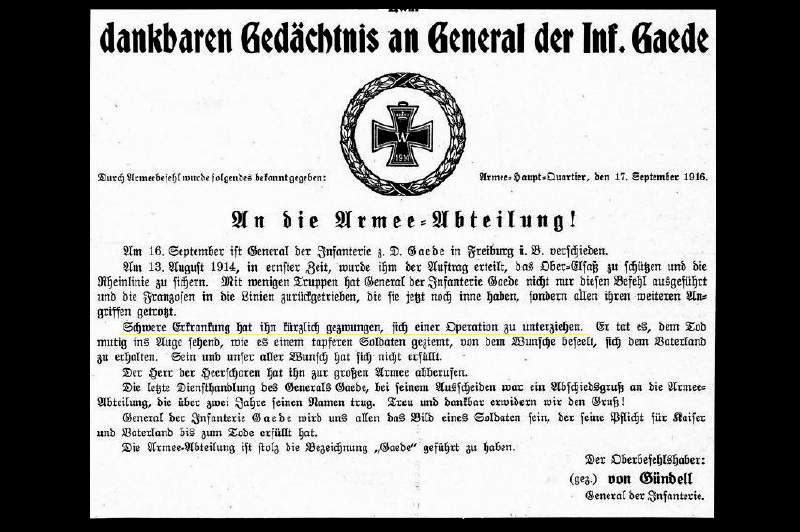
Two weeks later, on 16 September 1916, General Gaede would die unexpectedly at home in his sickbed in Freiburg due to a complication of peritoneal inflammation, which became fatal to the General.
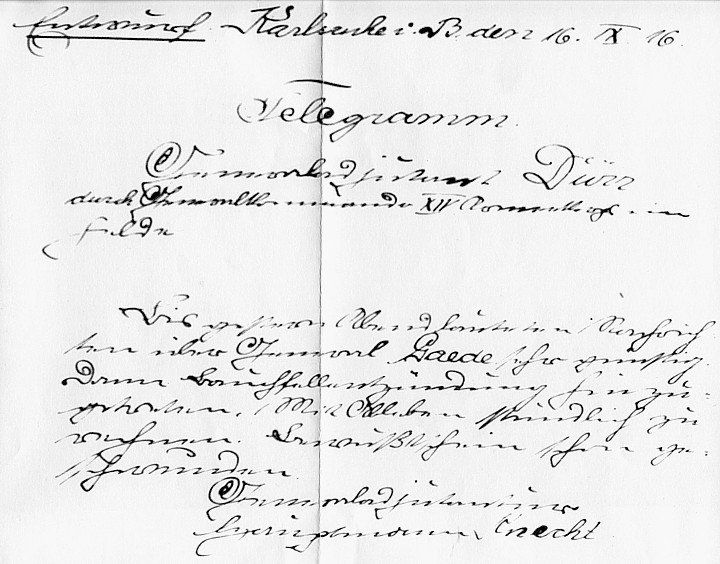

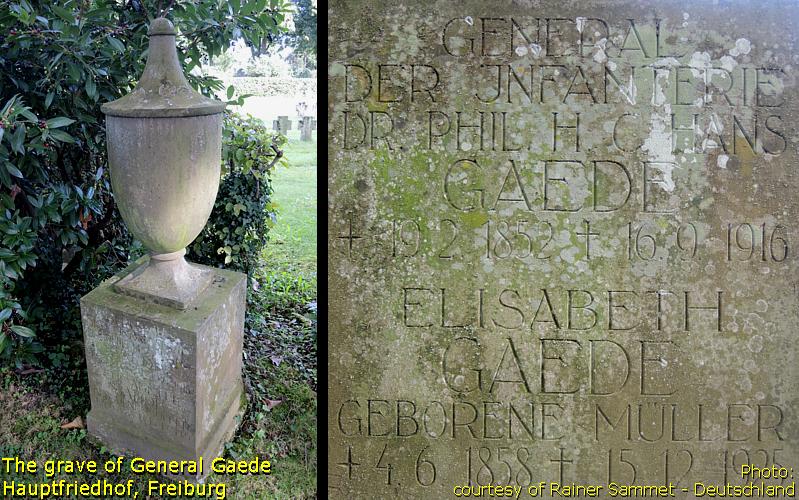
(Information about Gaede's cause of death: Thanks to
Dr. Rainer Sammet
, Freiburg, for his research in 2014 in the "Generallandesarchiv" in Karlsruhe, for making his scans of the documents available and for making his photo above available from the grave.)
The Composition of the "Armee-Abteilung Gaede"
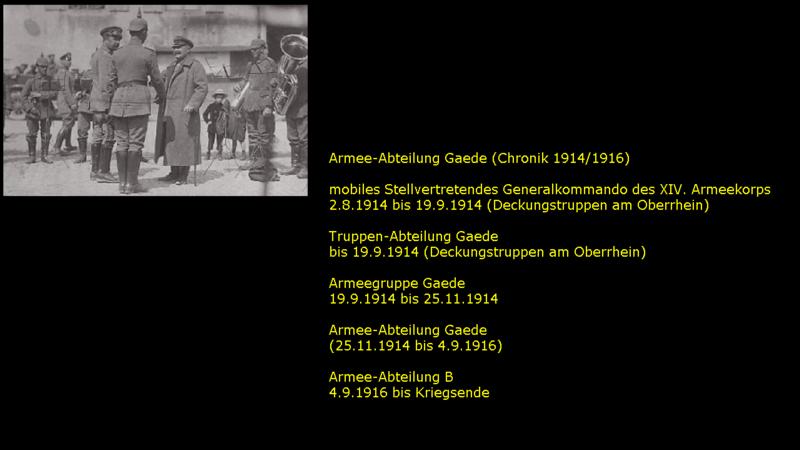
The name of Gaede's Army Detachment would be constantly changing: from the “Truppen-Abteilung Gaede”, through the “Armee- Gruppe Gaede”, to the “Armee-Abteilung Gaede”, until after his death it becomes again just “Armee-Abteilung B” .

The bulk of the Army Detachment of General Gaede, consisted of six Landwehr Brigades, mainly from the German states of Württemberg, Baden, Bavaria, Westphalia and the Rhineland.
These Landwehr Brigades were supported by four large Artillery Divisions, each accounting for around 18 to 32 pieces of artillery. But in addition there were also many other smaller units in the Armee-Abteilung , such as “Radfahrer Kompanies”, “Machine-Gewehr Züge”, “Licht und Signal Abteilungen”, and “Telefon Truppe”. All these smaller units are not included in this schedule here.
More importantly, however, for my story is the following: The Army Detachment will later grow, not only with regiments of the 187th Landwehr Division, but also with new , special units, which do not exist yet, at the beginning of the war. I am talking here about units, such as the " Württembergisches Gebirgs-Bataillon ", or the " Sturmbataillon Rohr " with which we will make acquaintance later during this lecture.
The expulsion of the German soldiers of French descent
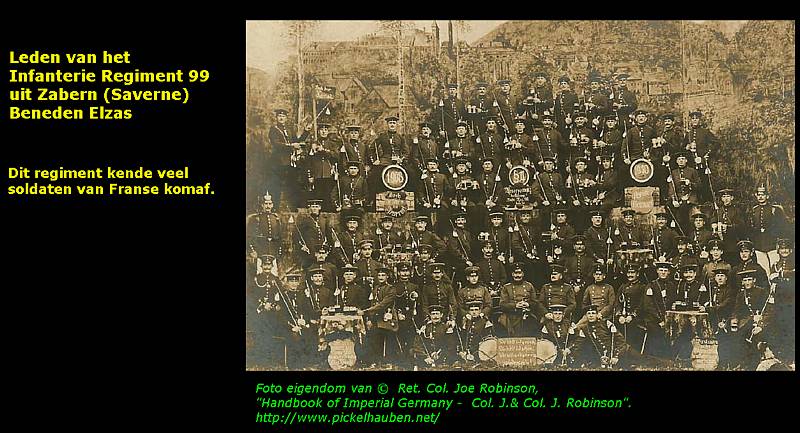
After this brief introduction to General Gaede I have arrived at my first reason to outline his special importance for the German army: the expulsion of the French soldiers, serving in the German army.
My first point is less about a possible innovation of Gaede than an example of his great influence on decisions of the Oberste Heeres Leitung.
As I said a few minutes ago, the Alsatian soldiers of French descent were in the eyes of the Germans only tramps. They were not just tramps, but they were also considered to be untrustworthy tramps. Objectively seen, there exists some reason for this attitude. Many of the young men among those 160,000 French, who had left the German Alsace in 1872, would after their arrival serve in the French army.
At the outbreak of the Great War in 1914 more young French men flee to the French side of the border, sometimes forced by an arrest warrant, like the artist Hansi (Jean-Jacques Waltz), or as it happened way more often, voluntarily.
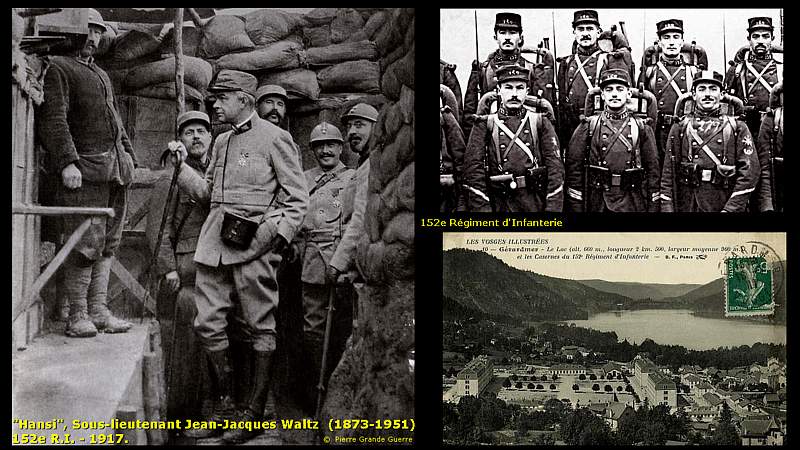
Many of these young men will end up in the regiment of the “Diables Rouges”, the Red Devils, the “ 152e Régiment d'Infantrie ”, also known as the "Quinze-Deux" or the "Fifteen-Two".
This famous regiment of the Vosges is in 1914 stationed in Gérardmer, a town that lies at the foot of the former Franco-German border crossing at the Col de la Schlucht. It is also the regiment which from 1918 to date is garrisoned in the city of Colmar.
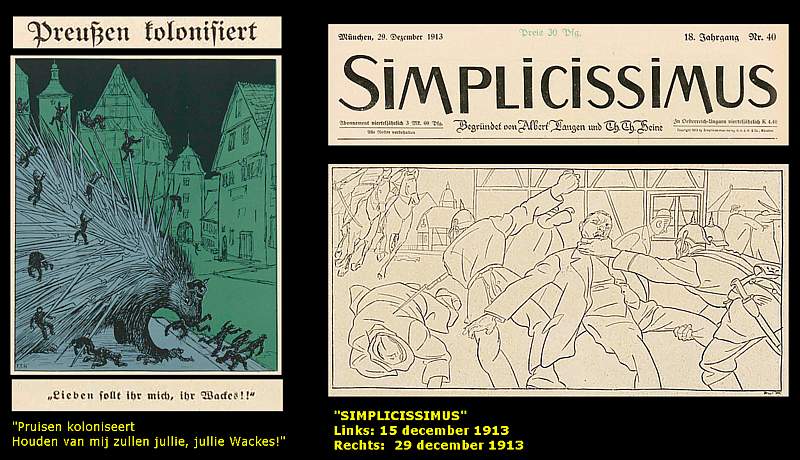
Because of the preconceptions about the "Wackes", but also because of this experience of these “renegade” French men, Gaede decides to advise the Oberste Heeres Leitung to deploy units comprising Alsatian soldiers of French descent as far away as possible from the French front, preferably on the eastern front, and if it cannot but be otherwise, then these units must be solely deployed on the Yzer Front in Belgium. This advice has also been taken over as a policy and implemented in practice.
On the French front no units with French Alsatian soldiers were deployed with two exceptions. These two exceptions were regiments from the garrison towns, Schlettstatt ( the current wine village, Sélestat ), and Colmar. But these units consisted mainly of Alsatians of German descent.
Now I come to my second point, why I consider Gaede not only as an influential General, but also as an innovator, a manager, who provides practical solutions for actual problems.
The Introduction of the Gaede helmet

But first we take a look at the cause of the introduction of the helmet.
In addition to the well-known 75mm. cannon, which the regular French units possessed, the “Diables Bleus”, the Blue Devils of the battalions of “Chasseurs Alpins”, had a relatively light but viciously rapid-fire gun with a calibre of 66 mm.
This gun was able with an explosive charge to shatter rocks near to the enemy, with such effect that the number of head wounds among Gaede's Landwehr men increased greatly.
Of course the leather Pickelhaube helmet of this early war period offered no protection at all against bullets, shrapnel, or rock splinters flying at full speed.
Not only the mountain cannon, but also the precision gunfire from the Chasseurs gave a lot of headaches to Gaede and his officers "Kopfschmerzen". How could they protect their soldiers against this threat?
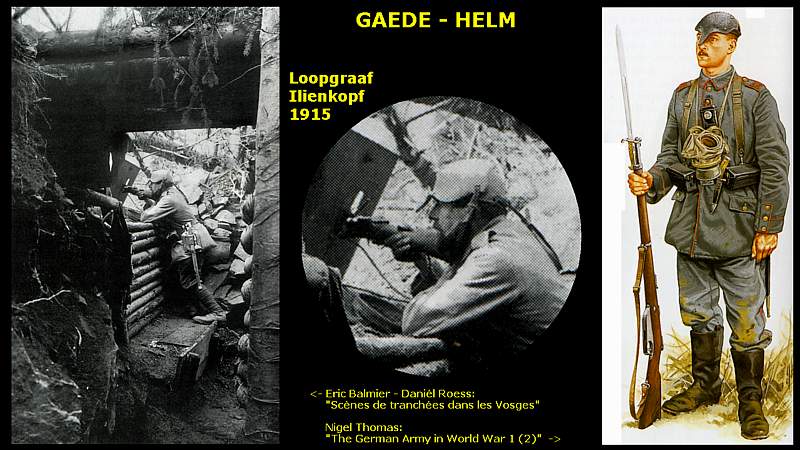
After repeated requests to Berlin for better head protection Gaede becomes impatient and he gives early in 1915 his chief of staff, Oberstleutnant Hesse an order to design a primitive form of a steel helmet and to produce 1500 units of these helmets, bearing the name, Gaede Model 1915.
As we see from this photo taken at the Ilienkopf, a Vosges mountain south of the Valley of Munster, the semicircular steel outer helmet with its distinctive nose protection was mounted on a cloth-covered, black leather skullcap. The steel plate was 6 mm. thick and the helmet had a weight of 2 kilograms. The back of the head was not protected.
Ultimately the War Department did not approve the Gaede helmets, and Hesse had almost to pay for the cost of the helmets himself. Hesse stopped the production of the helmets at once.

After the introduction of the much better Model 1916 Stahlhelm, designed by Hauptmann Schwerd, a professor in Technology, and the Naval Surgeon, Prof. Dr. Bier, the Gaede helmets became obsolete and were withdrawn, and most of these helmets were melted down for their steel.
I do not want to exaggerate Gaede's role here. Without Gaede and his helmet that better Stahlhelm of Schwerd and Bier would probably have been introduced and implemented. But I think that Gaede's role and Hesse's helmet are both remarkable. At least, seen from the point of view of the evolution of helmets, the Gaede helmet forms the "missing link" between the Pickelhaube helmet and the Stahlhelm.
The introduction of special mountain and ski troops
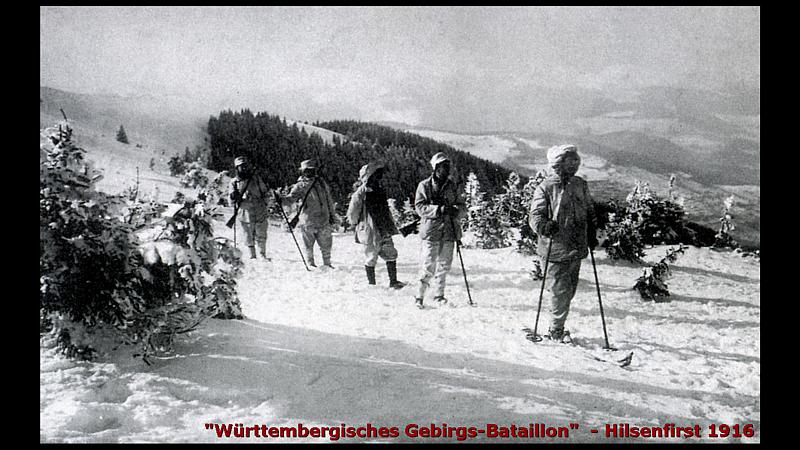
In my story about General Gaede and his test battlefield, I have now arrived at my third reason , the introduction of special mountain and ski troops , which at the beginning of the Great War did not exist as such on the German side

Already in early October 1914 two ski sports federations offer themselves collectively and voluntarily for use as mountain and ski troops. Following the example of the " Bayerische SkiVerband " the " Schwabische SchneeschuBund " from Württemberg offers on 21 October 1914 itself as a collective for the formation of a " freiwillige Skikorps ”.
In the same period of October 1914 the winter at the front in the Vosges sets in early. The mountains of the front are all covered with thick layers of snow.
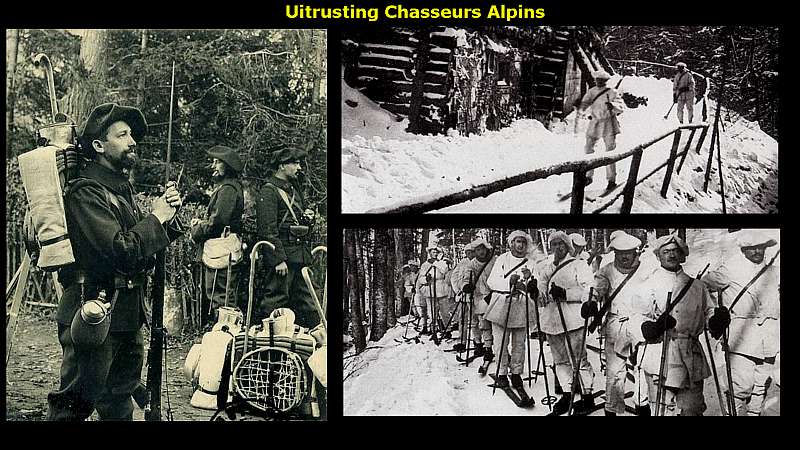
The “ Groupement des Vosges ” and in particular the “ 66th Infantry Division ”, which stands opposite the Armee-Abteilung Gaede , possesses right from the start of the war several battalions of Chasseurs Alpins.
The Blue Devils, mainly recruited in the mountainous regions of France, are always equipped with a cane, snowshoes and skis. They have been very adept at climbing steep hills and they are especially skilled in quick surprise attacks on skis.
Gaede possesses initially only on the Reserve Jäger Bataillon No. 8 and the Jäger Bataillon No. 14. These Jäger are partially able to ski. These Jäger ski to the fight, but then they step off from their skis. And at that early moment in the war -, according to my German sources,- these Jäger conducted their battles in a chaotic manner!
The majority of the generally somewhat older men of the Landwehr regiments were unable to cope with this rapid, overwhelming surprise attacks on skis of the Chasseurs Alpins.
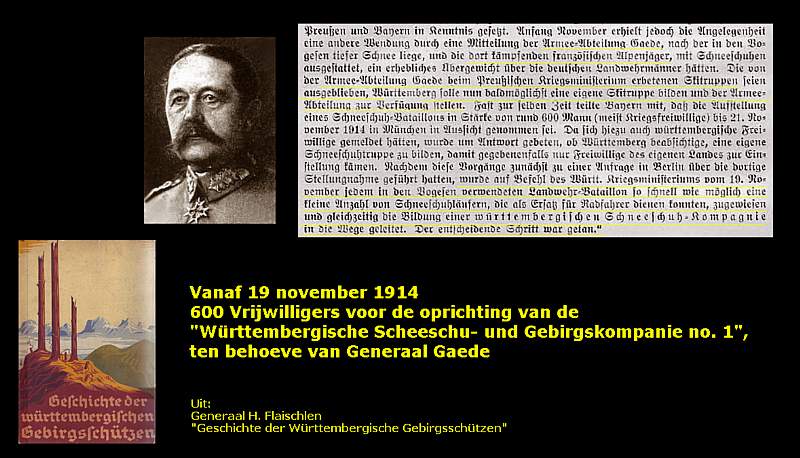
For this reason Gaede requests at the beginning of November 1914 via the Kriegsministerium to the Oberste Heeres Leitung to form special mountain and ski units from sports volunteers to be able to resist the surprise attacks of the Blue Devils and of course and in particular to carry out themselves successful attacks in the snow .
After an initial refusal, Gaede will be already on 19 November 1914 allowed the formation of his first elite unit, the "Württembergische Scheeschu-und Gebirgskompanie No. 1", composed of volunteers, sport skiers, of the "Schwabische Schneeschubund", which comes under command of Major Theodor Sproesser.
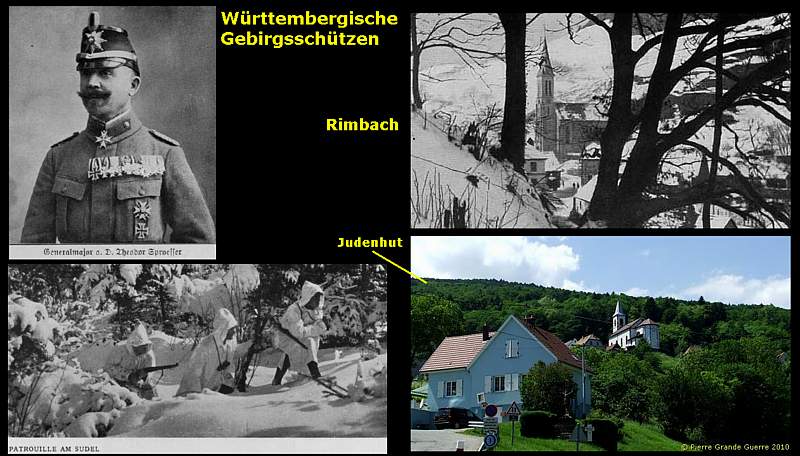
Despite the initial refusal of the Oberste Heeres Leitung but with the full support of the homeland of the "Schwabische Schneeschubund", Gaede receives elite ski troops from Württemberg, trained in Germany.
The " Württembergische Scheeschu- und Gebirgskompanie " is the first unit to arrive in the Vosges Front at the hamlet of Rimbach, becoming a new component of the 51. Gemischten Landwehr Brigade of the 7. Landwehr Division.
This company will be manning the outposts of the “Rimbach Stellung” on the Judenhut , the Sudelkopf, and the Hartmannswillerkopf.
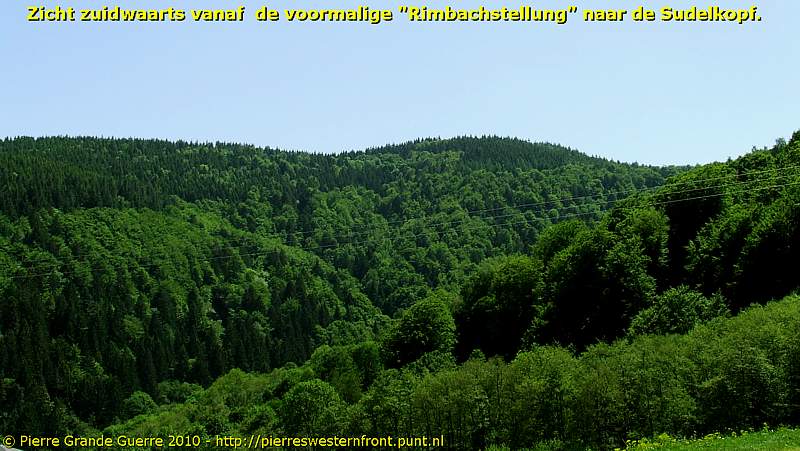
The exploits of these elite skiing units in the Vosges were so successful that the "Württembergische und Scheeschu Gebirgskompanie No. 1” quickly grew from a company to a battalion, the " Württembergisches Gebirgs-Bataillon ".
This battalion was among others involved in the fierce fighting in January 1916 for the final possession of the summit of the Hartmannswillerkopf.
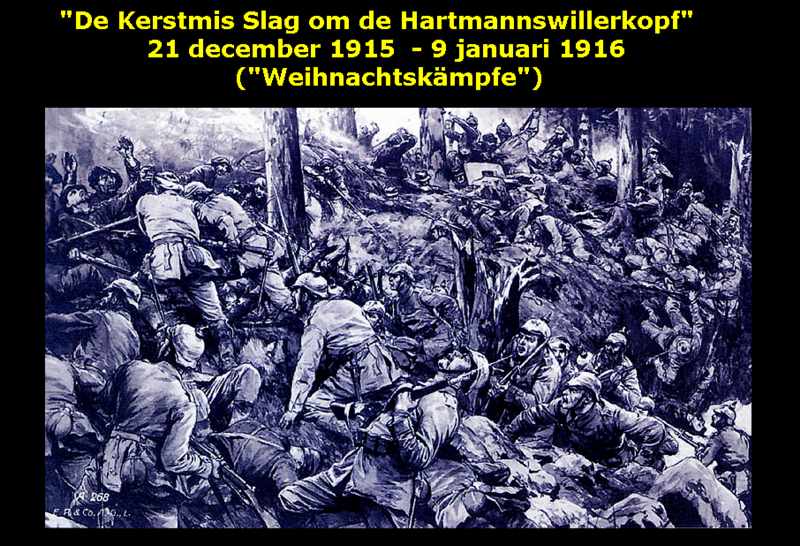
During this lecture this "Second Christmas Battle of the Hartmannswillerkopf" will show up a few times . So, now I am making a short bypass to introduce you to some facts about this battle.
This important battle took place between 21 December 1915 and 9 January 1916. These " Weihnachtskämpfe " for the Sudelkopf, the Hartmannswillerkopf, and the Hirzstein forms also the last great battle of any significance in the Vosges until the arrival of the Americans in 1918.
It was a very bloody battle, during which the Germans, with the loss of almost the entire Mecklenburg-Jäger Bataillon No. 14, narrowly managed to maintain at least a significant portion of the summit of the Hartmannswillerkopf .
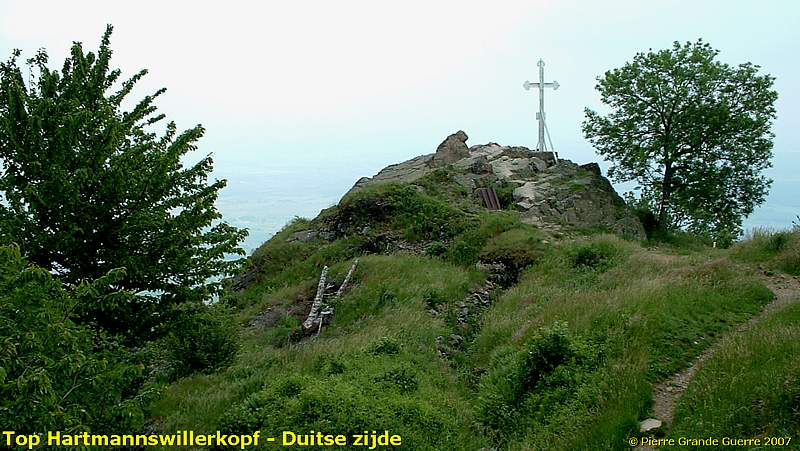
This story about the "Weihnachtskämpfe" forms a lecture in itself, but we will see later that this battle and this Hartmannswillerkopf formed together Gaede's ideal test site for the experiments with his new assault troops and his new attack tactics!
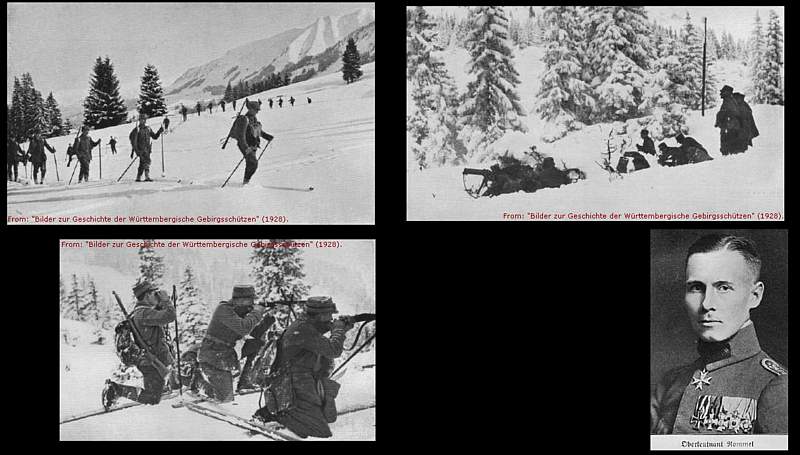
The overwhelming ski attacks of the " Württembergisches Gebirgs-Bataillon " play a decisive role during these battles on the Sudelkopf and the Jägertanne, just north of the Hartmannswillerkopf.
After this successful deployment of these ski troops, the battalion quickly grows further. After deployment on the Vosges Mountains, the Hilsenfirst, the Ilienkopf, and the Petit Ballon, the "Württembergische Gebirgs Regiment " is detached from February 1917 as a part of the Alpine Corps, to fight successively in Romania, Macedonia and on the Isonzo front.
A well known member of the first hour of the "Württembergische Scheeschu und Gebirgskompanie No. 1" was the “Oberleutnant und Kompagnieführer” of "Abteilung Rommel", known later as Field Marshal Erwin Rommel , the Desert Fox.
So, we have seen here that Gaede played an eminent role in the idea, the development, and the eventual deployment of his new specialist mountain and ski troops for fast surprise attacks, precisely in response to the tactics of the Chasseurs Alpins.
These elite mountain Württemberger Gebirgsschützen formed also the units, which would establish many successful achievements to their credit in the war on the Isonzo front.
"Sturmabteilungen"
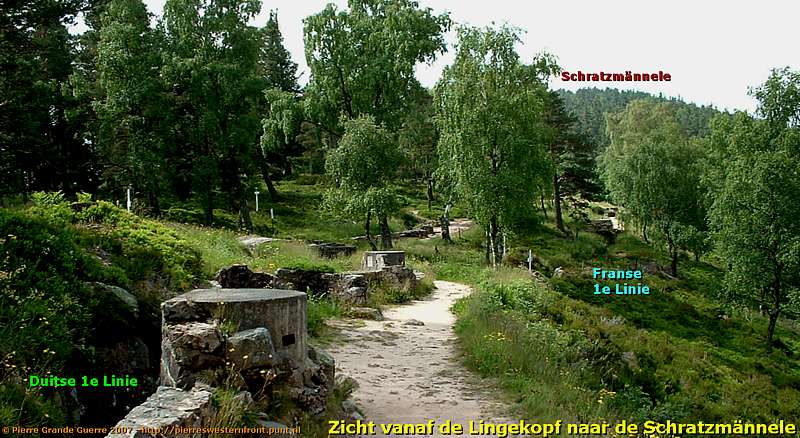
In the development of "Sturmabteilungen", Gaede has led at an early stage, in the summer of 1915, a "creative process" of tactical developments by experimenting with special shock troops or storm troops.
I will not deny that it was General Oskar von Hutier, who developed on the basis of his experiences during the Brushilov offensive in the summer of 1916, his tactic of "Sturmtruppe”. I will also not deny that it was this General Oskar von Hutier, who later in 1917 perfected his "Sturmtruppe" and who deployed them successfully on his battlefield!
But, Gaede used in the summer of 1915 the Lingekopf front as his training grounds for experimenting with a number of tactics, that later would be perfected in 1917, but which also would become part of these so-called "Hutier-taktiken".
I am talking here about the first, still experimental, but successful deployment of the " Sturmabteilung Rohr ". This was the origin of the storm troops, and Gaede had a guiding role in its formation.

From 19 February 1915, but especially from 15 June 1915 to 16 October 1915, the Lingekopf sector forms the focus of the fights in the Vosges.
This front sector begins in the north at the Wettstein pass, and then runs south via the peaks of the Hurlin (Combekopf), the Lingekopf, the Schratzmännele, the Barrenkopf and the Kleinkopf to the valley of Munster.

Early in 1915 General Gaede makes a request to the Kriegsministerium for the formation of special, lightly equipped, fast attacking units. On 4 March the Kriegsministerium gives the order to create a first "Sturmabteilung".
After training in April and May in Germany, and after a short and unsuccessful effort in June on the battlefield near Notre Dame de Lorette, the new "Sturmabteilung" is assigned in August 1915 to the Armee-Abteilung Gaede in the Vosges. After its arrival the "Sturmabteilung” is also equipped with the Gaedehelm !
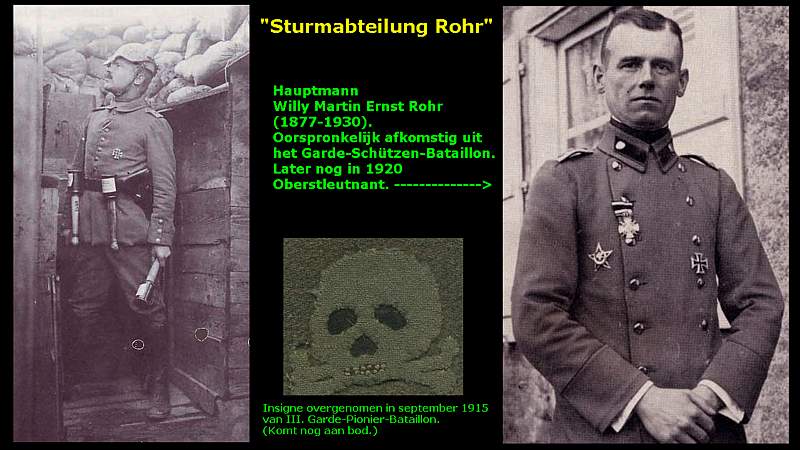
On 8 September 1915 Hauptmann Willy Rohr of the Garde-Schützen-Bataillon arrives at the Lingekopf front. He immediately takes command of the new "Sturmabteilung".
Under Rohr's leadership and of course with full consent and support of Gaede, the "Sturmabteilung no.5" as it is now called receives a major extension in its armament and equipment, namely: One platoon, armed with two heavy machine guns model 1908, a second platoon, armed with ten Minenwerfern, a Granatenwerfer, and a battery of four custom Russian 76 mm. cannons. And additionally as a third platoon a flamethrower platoon, armed with six small model "Kleif" flamethrowers. The tank of the "Kleif" flamethrower was "glued", carried on the back.
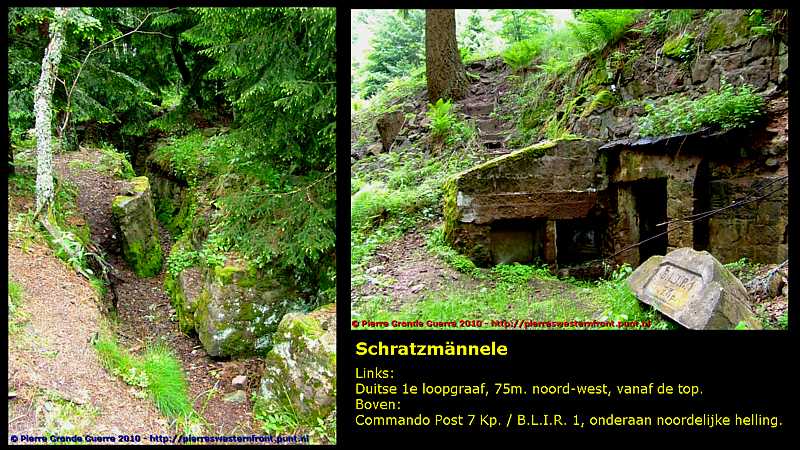
Rohr sought to compose a unit, combining all disciplines of each branch of the ground forces, to play a leading role in the attack. With this combined unit Rohr experimented with new fast attack tactics:
Fast advancing before and in front of the regular infantry to surprise the enemy with a combination of different weapons and to eliminate the main sources of the enemy’s fire. The grenade, the typical weapon of the Pioneer, will always remain central to Hauptmann Rohr’s tactics of rapid, overwhelming attacks.
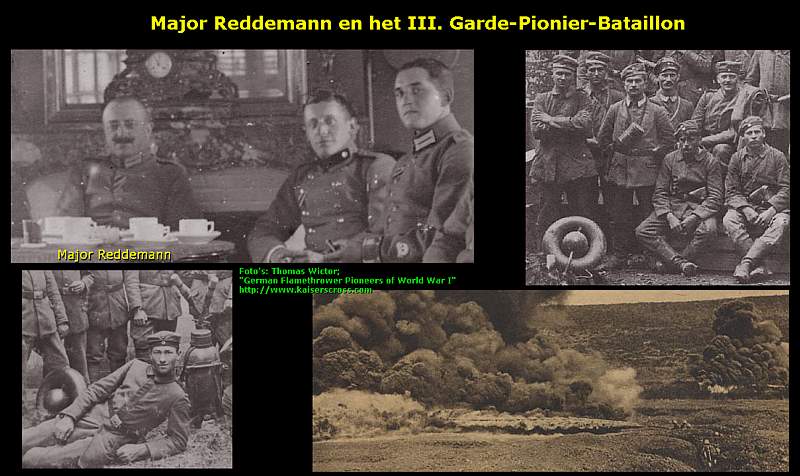
Later in September 1915, the fire officer from Posen, Major Reddemann arrives in the Vosges, with 2 companies ( 9 and 10 ) of the III. Garde-Pioneer Battalion , again at the insistence of Gaede.
Reddemann’s first original and still experimental "Flammenwerfer Abteilung Reddemann" consists entirely of 48 men, led by a sergeant, who are all in their civilian lives professional fire fighters in Posen!

Before Reddemann’s arrival in the Vosges, already on 18 March 1915, the "Flammenwerfer Abteilung Reddemann" is growing by order from above into a battalion of 800 men. The battalion is supplemented by members of the core of the III. Garde-Pioniere Battalion, but also by volunteers from other units. Almost all these men are fire fighters in civilian life.
The four companies of the battalion, ( numbered from 9 to 12 ), each comprise 139 men. A company contained three platoons ("Kampfzüge"), each armed with four to six large "Grof" flame-throwers and six small "Kleif" flamethrowers. The "Grof" and the "Kleif" were both invented in 1908 by Reddemann’s good friend, Richard Fiedler.
Two companies ( 9 and 10 ) of the III. Garde-Pioneer Battalion arrived in the Hartmannswillerkopf sector for only their fifth combat action, after their flamethrowers were previously deployed elsewhere at the front.
Their previous engagements were in February 1915 in the Argonne near Malancourt and Vauquois, in May 1915 in the Artois at Neuville-St . Vaast ( Vimy ), and then, as many British historians claim, " for the first time in history ", on 30 July 1915, at Hooge in Belgium.

During the month of September 1915 two companies of the III. Garde-Pioneer Battalion carried out on the Hartmannswillerkopf nine well-coordinated flamethrower attacks. The Pioneers also deployed five extra large flamethrowers, designed by Leutnant Schlayer of Kavellerie Kraftwagen Kolonne 24. The Schlayer flamethrower launched a flame about 40 m. long from a tank of 280 litres of petrol.
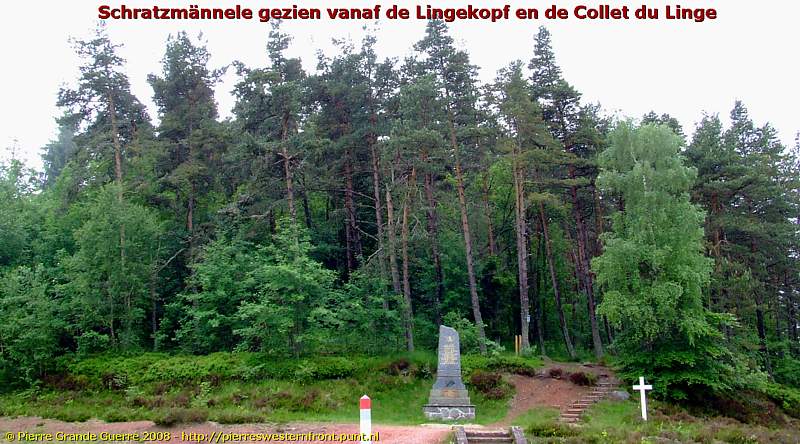
Detached from Reddemann's III. Garde-Pioneer Battalion Rohr’s "Sturmabteilung No. 5" receives a month later, in October, at the Lingekopf front an additional unit , a fourth flamethrower platoon, equipped with 6 "Grof" and 6 "Kleif" flamethrowers. Rohr's dream of a perfect fighting unit of a "Sturmabteilung" had become reality. He now has an extra 12 flamethrowers!
"Sturmabteilung Rohr", at least the second company, engages in combat for the first time on 12 October 1915, on the Lingekopf front. On that day the "Sturmabteilung Rohr" leads the attack on the French positions on the Schratzmännele, the mountain opposite the Lingekopf. This attack is in fact the first, successful storm assault by shock troops!

With the support of their ten Minenwerfern and their four Russian guns, which harass the French artillery and machine gun nests, and after firing six of these "Grof" flamethrowers, the Pioneers used their grenades to overwhelm the French trenches.
Regular infantry ( B.L.I.R. 2 ) follow behind the attack of the pioneers to the newly conquered positions to secure these and strengthen the trenches with sandbags. During this successful attack only 4 Pioneers die.
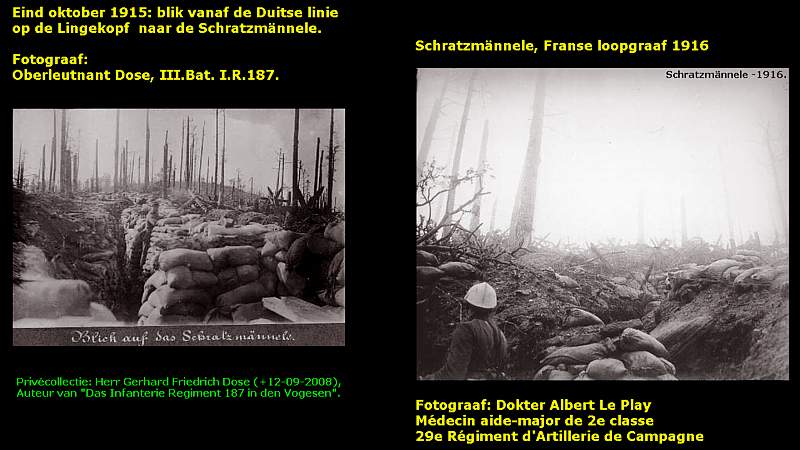
This operation on the penultimate day of the "Battle of the Lingekopf" was so successful that Rohr will later continue to use this storm tactic as the core of his training for new storm units. From December, Rohr will also train Jäger and other infantry units in his attack tactics; for instance, the Reserve Jäger Battalion No.8.

After October 1915 the focus of the battle moved from the Lingekopf sector to the south, to the Hartmannswillerkopf , where in December 1915 the battle flares up.
On 22 December 1915, during the second day of the " Weihnachtskämpfe ", when the German objective that day was conquest of the eastern Aussichtsfelsen, the Panorama Rock of the Hartmannswillerkopf, General Gaede deploys beside the Reserve Jäger Bataillon No. 8 also Reddemann’s two flamethrower companies, 9 and 10, and Rohr's entire "Sturmabteilung No.5"!
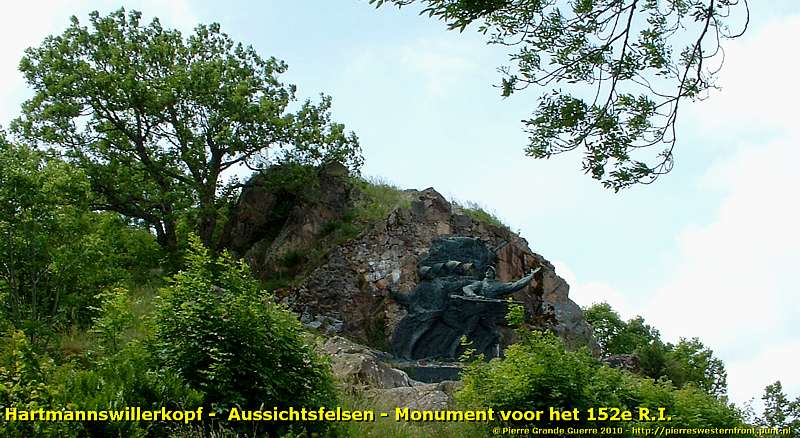
Again, the combined attack tactics on the Aussichtsfelsen, with use of many flamethrowers, prove to be a great success.
At the end of this battle, on 8 and 9 January 1916, Rohr's "Sturmabteilung" will play a leading role in the attacks on the Hirzstein, the mountain south of the Hartmannswillerkopf. I will come back to this attack on the Hirzstein later. The "Sturmabteilung Rohr" will later even become a " Sturmbataillon Rohr".
I think it is now clear that General Gaede oversaw the process which created a new military entity, storm troops, "Sturmtruppe".
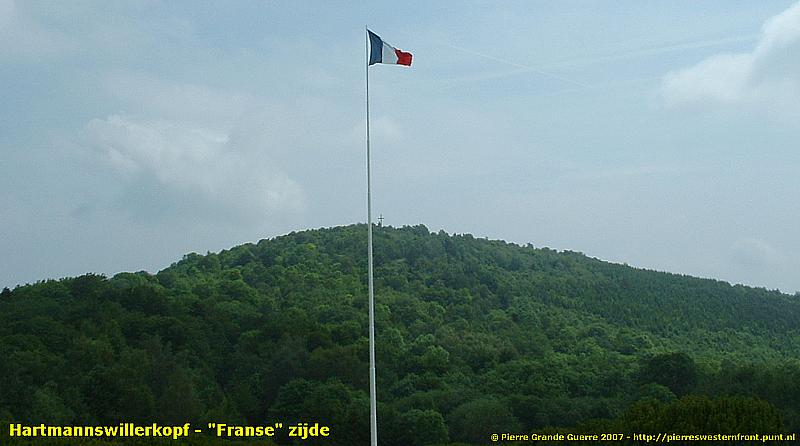
Now I have arrived at my final reason, why I consider Gaede a significant innovator in tactics. Under Gaede's responsibility and on his test site the German Pioniere successfully experimented with the coordinated and planned fire of a group of " Minenwerfern" of different calibre.
I would now like to bring you all the way back in time to Christmas 1914, but we shall remain on the Hartmannswillerkopf.

It is amazing that this strategically important summit, 956 metre high, attracts the attention of the two sides only until around Christmas 1914.
On Christmas Day 1914 a small unit of four men of the 28th Battalion of Chasseurs Alpins set up only one outpost in a type of log cabin, some 150 m from the western edge of the spherical top.
The next day the Chasseurs fire on a unit of 43 men of the Württembergische Landwehr Infantry Regiment 123 , which is trying to establish a post on the eastern Aussichtsfelsen. Immediately the Germans attack the French post, at first weakly, but these attacks will significantly intensify during the coming days.
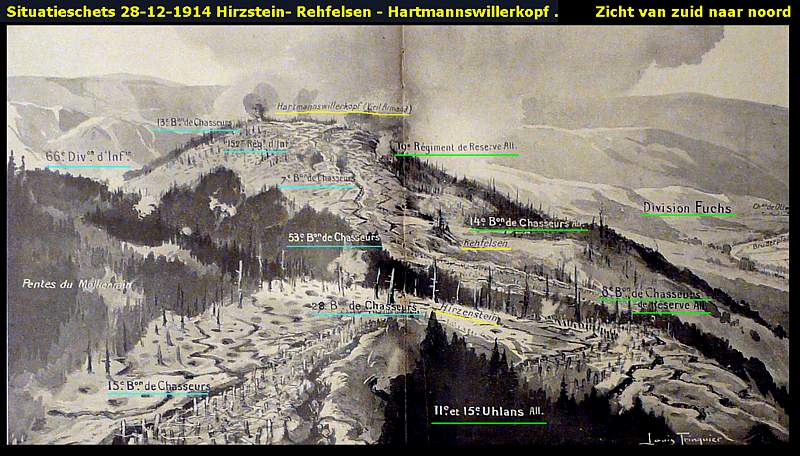
Three days later, on 28 December 1914, other units of the 28th B.C.A. occupy the Hirzstein.
From 28 December 1914 to 19 January 1915 the Germans make every effort to expel the Chasseurs from the peaks of the Hartmannswillerkopf and the Hirzstein with two Uhlanen Regimente, the 11th and 15th, with two Jäger Bataillone, the 8th and 14th, the Infantry Regiment 25 , and the Landwehr Infantry Regiment 123 .
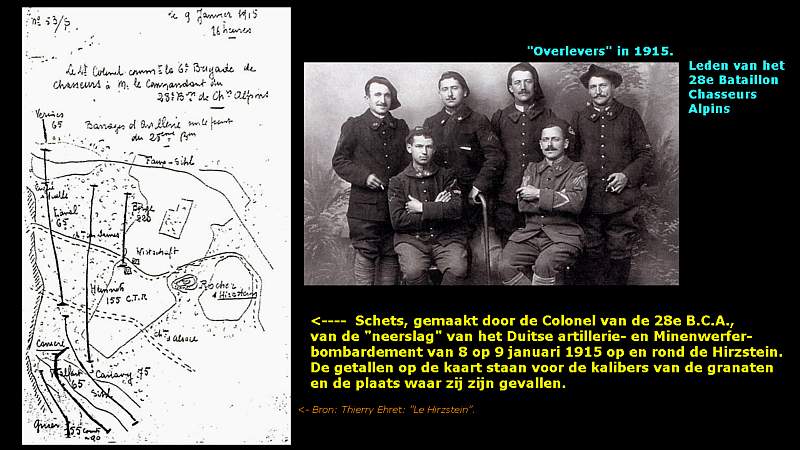
The German artillery bombarded the Hirzstein constantly; for example, on 8 and 9 January 1915.
Ten days later, on 19 January 1915, the persistent presence of the 28th Battalion of Chasseurs Alpins ended. On that day Gaede deploys a new unit: " Pioniertrupp Turck ", officially described as "Minenwerferabteilung No. 6". This unit consists of 46 Pioneers, and is led by Leutnant Türck and Leutnant Killian.
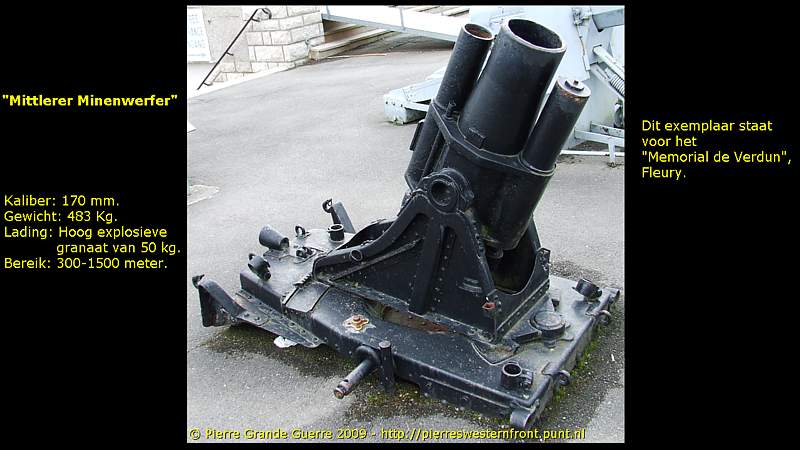
The group is equipped with 4 medium Minenwerfer of 170 mm. The group concentrates their fire on the trenches of the Chasseurs on the Hirzstein, with decisive success.
That day, on the Hartmannswillerkopf the French are pushed back almost to the foot of the present cemetery on the Col du Silberloch. With this victory, and especially with the conquest of Hirzstein, this "PioniertruppTurck" provided the key to the success of the 51th Landwehr Brigade.
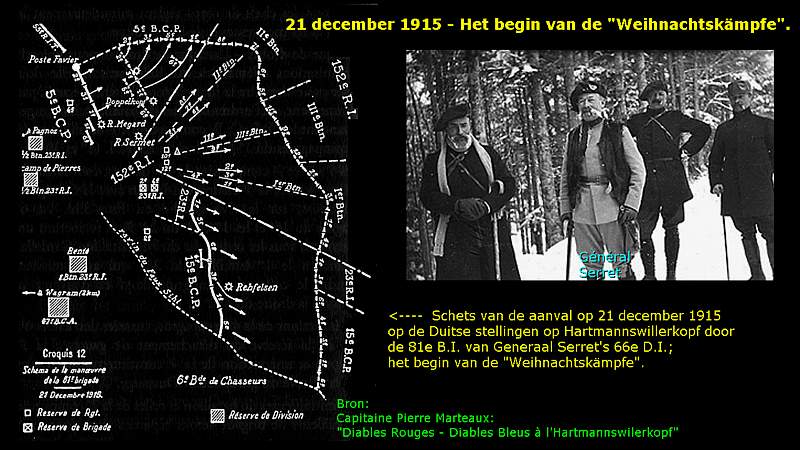
We continue to stay with the Minenwerfer, the Hirzstein and the Hartmannswillerkopf, but we now make a leap forward in time to Christmas 19 15 .
As previously stated, the French General Serret launches an offensive on the summits of the Sudelkopf, the Hartmannswillerkopf and the Hirzstein before Christmas, on 21 December 1915, with his 66th Division d'Infanterie.
Serret has two infantry brigades, including the 81st with the Red Devils regiment, the 152nd, and nine battalions of Chasseurs Alpins. Again the 6th Brigade of Chasseurs Alpins captures the quartz rock of the Hirzstein. The 7th and the 27th battalion are involved in these actions, but the 28th Battalion of Chasseurs Alpins leads the attack.
While the " Weihnachtskämpfe " still rages, Gaede receives on 28 December 1915 reinforcements for his Armee-Abteilung. On that day the 187th Landwehr Division arrives under the command of the then Generalleutnant, Erich von Gundell. In the wake of von Gundell’s arrival, there come no fewer than 7 Minenwerferabteilungen. One of these is the combined Minenwerfer Kompagnie 132, which is equipped with 23 mortars of light, medium and heavy calibre. This is placed immediately under the command of Leutnant Killian.
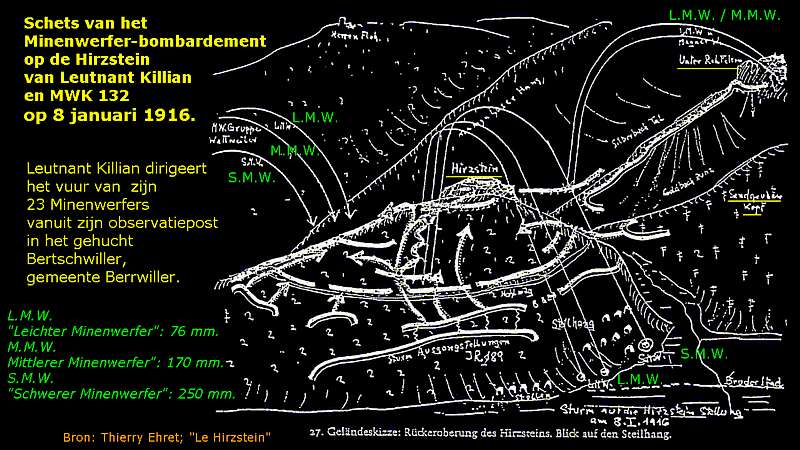
At the same time, and together with the other more traditional artillery Leutnant Killian opens his Minenwerfer-bombardment on the Hirzstein on January 8 from 3 sides. The preliminary bombardment lasts about 10 hours.
According to the chronicler of the 28th Battalion of Chasseurs Alpins this sophisticated precision bombardment is, "un effroyable bombardment", a frightening event.
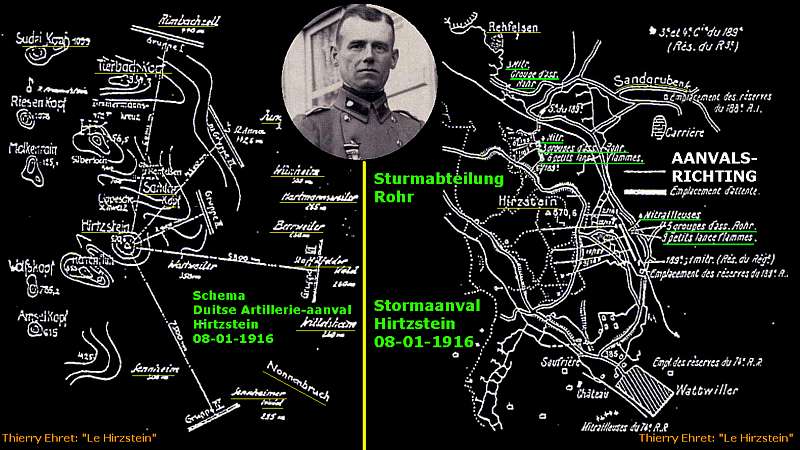
After this bombardment Gaede's other new unit, the "Sturmabteilung Rohr" attacks. Rohr’s Pioniere advance in front of the Infantry Regiment 189 and they attack the top of the Hirzstein to drive the Chasseurs off the rock.
Rohr is also fighting with his fourth extra platoon of flamethrowers of the Garde-Pioniere-Bataillon, that wears its skull-and-bones insignia in Rohr’s special unit, now marked with the number 5 of "Sturmabteilung 5".
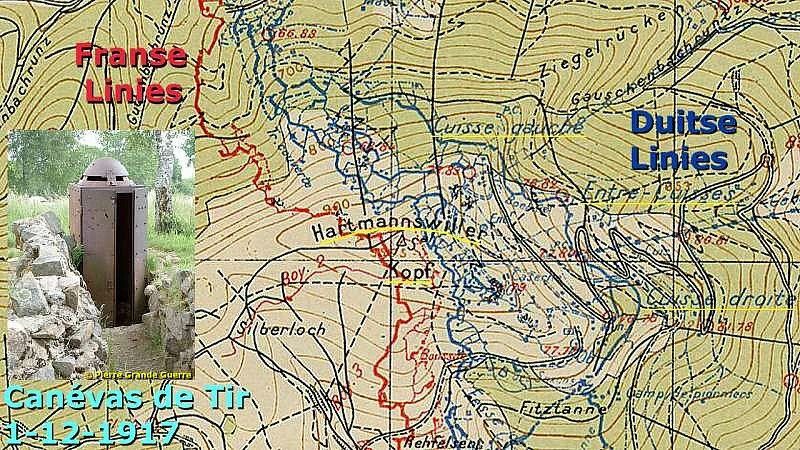
A day later, on 9 January 1916, the “Second Christmas Battle of the Hartmannswillerkopf” is over. The Germans take at least 1,108 Chasseurs prisoner of war. Let us not forget the 6,000 French soldiers and 6,000 German soldiers, who perished at the Hartmannswillerkopf.
The largest part of the Sudelkopf in the north remains until the end of the war for in German possession. The Hirzstein will remain in German possession. And on the Hartmannswillerkopf the Germans dominate until the end of the war on the northeast and the largest part of the top.
The south-western tip and south-western slopes will remain in French hands.
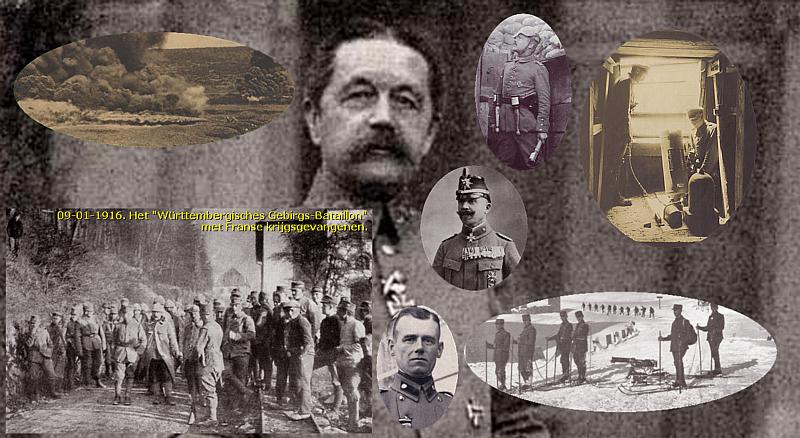
This successful day of attacks of 8 January 1916 must have been very important for Gaede. Those attacks generated a final victory on the front of the Hartmannswillerkopf, but Gaede could not have known this on that day.
But it was obviously for this innovator a particularly successful conclusion of the dedicated deployment of his new special forces; of Major Sproesser's Württembergische Gebirgsbataillon on the Jägertanne, of Major Reddemann’s Flammenwerfer Kompanies at the Hartmannswillerkopf, of Sturmabteilung Rohr with his 18 flamethrowers at the Hartmannswillerkopf , and of the combined Minenwerferabteilung Killian on the Hirzstein.
Final
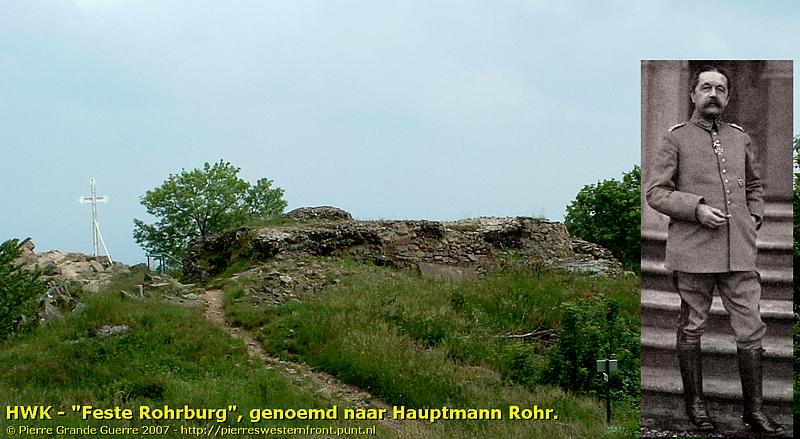
I hope, dear friends, that I have now sketched for you the special significance of the forgotten General Gaede, not only his significance as a man of influence with the Oberste Heeres Leitung, but also as an initiator and successful tactician, improvising to manage change.
Gaede was a General, who was open-minded to new ideas to solve current problems and who offered his officers the freedom and space to develop new ideas. Of course, the testing of these tactics in combat was bought at the expense of the lives of many French soldiers.
This forgotten General, this innovator, presided over the birth of all these special units with their special combat methods. Later in the war they would be perfected and become much more successful. But Gaede made the first experiments with this type of warfare on his test ground of the Southern Vosges.
Thank you for your attention.
Pierre Grande Guerre - 28 April 2012
Main sources
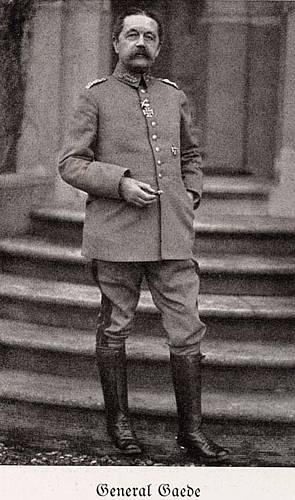
| Alsace - Period 1870-1914 Abbé E. Wetterlé: “ L’Alsace et la Guerre ” Charles Downer Hazen: “ Alsace-Lorraine Under German Rule ” About Gaede himself Alas many interesting sources on websites, mainly of German origin, have disappeared over the last years for reasons only known to the webmanagers of these sites. All other sources ares scattered over several of these sources below and to be ( alas partly ) found in the German Wikipedia lemma and its links: http://de.wikipedia.org/wiki/Hans_Gaede and further on on: " Das Deutsche Reich und der 1. Weltkrieg - 1914-1918 " Thierry Ehret: sundgaufront.j-ehret.com/pdf/Gaede.pdf ! Gaede Helmet Ludwig Baer: “ The History of the German Steel Helmet – 1916-1945 ” Fellow members of the Pickelhaubes.com Forum ! Ret. Col. J. & Ret. Col J. Robinson: “ Handbook of Imperial Germany ” Nigel Thomas: “ The German Army in World War I ” Württembergische Gebirgs Bataillon Eric Balmier - Daniél Roess: “ Scènes de tranchées dans les Vosges “ Gen. Flaischlen & Gen. Sproesser: “ Die Wüttembergische Gebirgsschützen ” The Linge Eric Balmier - Daniél Roess: “ Scènes de tranchées dans les Vosges “ Herr G.F. Dose (+12-09-2009): “ Das Infanterie Regiment 187 in den Vogesen ” Sturmabteilung Rohr and Abteilung Reddemann Nigel Thomas: “ The German Army in World War I ” Chris Boonzaayer and others: “ The Soldiers Burden ”. Thomas Wictor: “ German Flamethrower Pioneers of World War I ” Hartmannswillerkopf / le Vieil Armand Hauptmann Goes: “ Der Hartmannsweilerkopf ” ( French translation ) Capitaine Pierre Marteaux: “ Diables Rouges – Diables Blues à l’Hartmammswillerkopf ” Hans Peter Tombi: “ Der Hartmannsweilerkopf Route 1 - Von der Krypte bis zum Jägerdenkmal “ , “Der Hartmannsweilerkopf Route 2 Vom Gipfelkreuz zum Schwabenheim ”. Louis Scheromm: “ Au Sudel En Première Ligne ” Hirzstein Thierry Ehret: “ Le Hirzenstein ” General sources concerning Gaede and the Vosges "Das Archiv zum 1. Weltkrieg" . Gabriël Hanotaux: “ L‘Histoire Illustrée de la Guerre de 1914” . Eric Balmier - Daniél Roess: “ Scènes de tranchées dans les Vosges “ Philippe Springer: “ 1914-1916 L’Alsace en Guerre ” The French war diaries, the “ Journaux des Marches et Opérations ”, of the 152e R.I. and the 28e B.C.A. " Das Deut sche Reich und der 1. Weltkrieg - 1914-1918 " In great gratitude to my American friends, Ret. Col. Joe Robinson and George Wylie, and to my Australian friend, Brett Butterworth, for the use of their period photos, and to my Dutch friend, Aart Jan van Loon, who made the photos of the lecture event itself and thanks also to my English friend, Dr. Michael Brett-Crowther, for correcting patiently my English translation! Danke schoen, Dr. Rainer Sammet! Thank you all, gentlemen! Continue to my next WFA lecture about the Vosges: " The Difficult Start of the L.I.R. 123 - 1914-1915 " |










